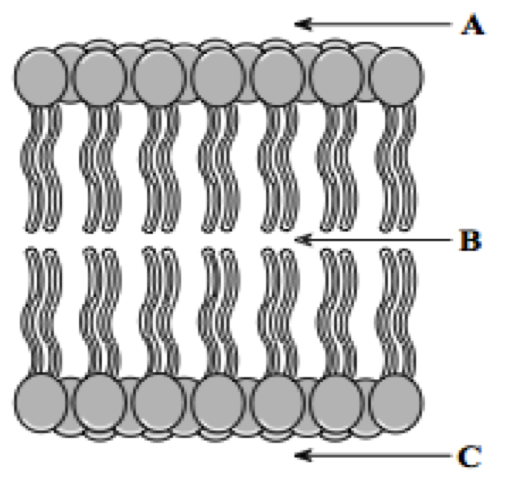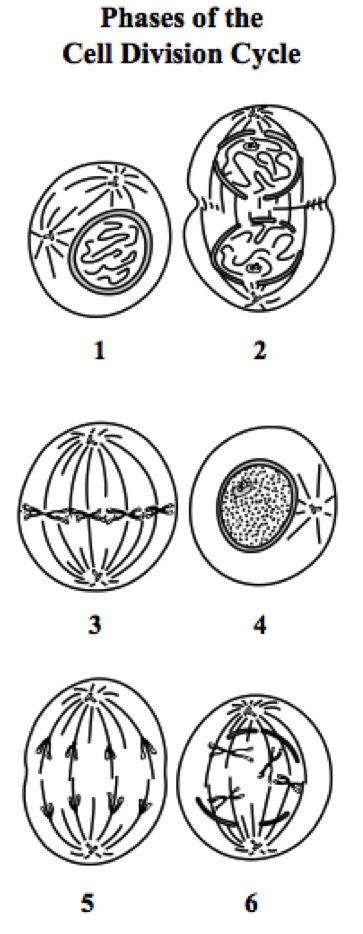Bio 2 Warm-up Quiz #9
.png)
- 1.
Which of these supports the cell theory as it is stated today?
- A.
New cells are produced by division of existing cells.
- B.
All organisms are composed of more than one cell.
- C.
Cells must contain a nucleus.
- D.
Not all cells are alive.
Correct Answer
A. New cells are produced by division of existing cells.Explanation
The statement "New cells are produced by division of existing cells" supports the cell theory as it is stated today because it aligns with the fundamental principle of cell division and reproduction. According to the cell theory, cells arise from pre-existing cells through the process of cell division. This concept is a key component of the modern understanding of cellular biology and is supported by extensive scientific evidence.Rate this question:
-
- 2.
Cells are able to remove large amounts of material using __.
- A.
Endocytosis
- B.
Exocytosis
- C.
Phagocytosis
- D.
Osmosis
Correct Answer
B. ExocytosisExplanation
Exocytosis is the process by which cells release large amounts of material. It involves the fusion of vesicles containing the material with the cell membrane, leading to the release of the contents outside the cell. This process is important for various cellular functions such as neurotransmitter release, hormone secretion, and removal of waste materials. Therefore, exocytosis is the correct answer to the question as it accurately describes the cellular mechanism for removing large amounts of material.Rate this question:
-
- 3.
What gives water many properties that are important to living things?
- A.
Temperature
- B.
Density
- C.
Hydrogen bonds
- D.
Specific heat
Correct Answer
C. Hydrogen bondsExplanation
Hydrogen bonds give water many properties that are important to living things. These bonds are formed between the hydrogen atoms of one water molecule and the oxygen atom of another water molecule. This results in a cohesive force that holds water molecules together, giving water a high surface tension. Hydrogen bonds also give water a high boiling point and specific heat capacity, allowing it to absorb and release heat slowly. Additionally, hydrogen bonds contribute to water's ability to dissolve many substances, making it a versatile solvent for biological processes.Rate this question:
-
- 4.
In the lock-and-key model of enzyme function shown in Figure 2.2, what is happening in step 2?
- A.
The catalyzed reaction is releasing a product.
- B.
The active sites are restructuring the enzyme.
- C.
The enzyme is creating bonds between the substrates.
- D.
The substrates are beginning to separate from each other.
Correct Answer
C. The enzyme is creating bonds between the substrates.Explanation
In step 2 of the lock-and-key model of enzyme function, the enzyme is creating bonds between the substrates. This means that the enzyme is facilitating the formation of chemical bonds between the substrates, which is an important step in the catalyzed reaction. This process allows the substrates to undergo a chemical transformation and form a product.Rate this question:
-
- 5.
What is the function of the structure shown in the diagram?
- A.
Make cytoplasm
- B.
Regulate what goes in/out of a cell
- C.
Manufacture lipids
- D.
Produce proteins
Correct Answer
B. Regulate what goes in/out of a cellExplanation
The structure shown in the diagram is most likely a cell membrane. The cell membrane is responsible for regulating what goes in and out of a cell, controlling the movement of substances such as ions, nutrients, and waste products. It acts as a barrier, allowing certain molecules to pass through while preventing others from entering or leaving the cell. This regulation is essential for maintaining the cell's internal environment and ensuring its proper functioning.Rate this question:
-
- 6.
When graphing experimental results, you should place the ______ onto the y axis.
- A.
Constant
- B.
Independent variable
- C.
Dependent variable
- D.
Bar
Correct Answer
C. Dependent variableExplanation
When graphing experimental results, the dependent variable should be placed onto the y-axis. The dependent variable is the variable that is being measured or observed and is expected to change in response to the independent variable. By placing the dependent variable on the y-axis, we can visually represent the relationship between the independent and dependent variables and observe any patterns or trends in the data.Rate this question:
-
- 7.
The structures labeled B would be made up of ___.
- A.
Cellulose
- B.
Lipid
- C.
Protein
- D.
Fatty acids
Correct Answer
C. ProteinExplanation
The structures labeled B would be made up of protein because proteins are macromolecules composed of amino acids. They are involved in various biological functions and can form complex structures such as enzymes, antibodies, and structural components of cells and tissues.Rate this question:
-
- 8.
Transport proteins play a role in both ___.
- A.
Passive and active transport.
- B.
Exocytosis and endocytosis.
- C.
Diffusion and vesicle transport.
- D.
Phagocytosis and passive transport.
Correct Answer
A. Passive and active transport.Explanation
Transport proteins are responsible for facilitating the movement of molecules across cell membranes. They can either assist in passive transport, where molecules move down their concentration gradient without requiring energy, or active transport, where molecules are moved against their concentration gradient and require energy. Therefore, transport proteins play a role in both passive and active transport.Rate this question:
-
- 9.
Scientists found that, over a period of 200 years, a mountain pond was transformed into a meadow. During that time, several communities of organisms were replaced by different communities. Which of these best explains why new communities were able to replace older communities?
- A.
The original species became extinct.
- B.
Species in the older community died from old age.
- C.
The abiotic characteristics of the habitat changed.
- D.
Diseases that killed the older organisms disappeared.
Correct Answer
C. The abiotic characteristics of the habitat changed.Explanation
The abiotic characteristics of the habitat changed. This explanation suggests that the transformation of the mountain pond into a meadow was due to changes in the non-living factors of the environment, such as temperature, water availability, and soil composition. These changes likely created a new set of conditions that favored the establishment and growth of different communities of organisms. It is plausible that the original species did not become extinct, but rather were unable to adapt to the new abiotic conditions, leading to the replacement of the older communities by new ones.Rate this question:
-
- 10.
During the last part of M phase in an animal cell, the ___ would begin developing.
- A.
Signs of decomposing
- B.
Spindle fibers
- C.
Cell plate
- D.
Cleavage furrow
Correct Answer
D. Cleavage furrowExplanation
During the last part of M phase in an animal cell, the cleavage furrow would begin developing. The cleavage furrow is a shallow groove that forms around the equator of the cell during cytokinesis. It is responsible for dividing the cytoplasm of the cell into two daughter cells. The formation of the cleavage furrow is essential for the completion of cell division in animal cells.Rate this question:
-
- 11.
The electron transport chain produces water and ATP. Where do the hydrogen atoms come from that are used to form water?
- A.
Oxygen
- B.
Carbon dioxide
- C.
NADH and FADH2
- D.
The Calvin Cycle
Correct Answer
C. NADH and FADH2Explanation
NADH and FADH2 are the electron carriers produced during cellular respiration. These electron carriers donate their electrons to the electron transport chain. As the electrons pass through the electron transport chain, they combine with hydrogen ions (H+) and oxygen (O2) to form water (H2O). Therefore, the hydrogen atoms used to form water come from NADH and FADH2.Rate this question:
-
- 12.
In membranes, phospholipids are arranged with their polar heads to the outside and their nonpolar tails to the inside. With this arrangement, where would you MOST likely find water molecules?
- A.
A only
- B.
B only
- C.
C only
- D.
A and C only
Correct Answer
D. A and C onlyExplanation
Water molecules are polar, with a positively charged end and a negatively charged end. Therefore, they are attracted to the polar heads of the phospholipids in the membrane. Since the polar heads are arranged on the outside of the membrane, water molecules would most likely be found on the outside (A) and on the inside (C) of the membrane.Rate this question:
-
- 13.
Which of the following correctly lists the phases of the cell cycle starting with interphase?
- A.
4,1,6,3,5,2
- B.
4,6,1,5,2,3
- C.
4,1,2,3,6,5
- D.
4,1,5,6,3,2
Correct Answer
A. 4,1,6,3,5,2 -
- 14.
What provides the electron transport chain in cellular respiration with the energy it needs to function?
- A.
Krebs Cycle
- B.
Glycolysis
- C.
ATP synthesis
- D.
Chlorophyll
Correct Answer
A. Krebs CycleExplanation
The Krebs Cycle, also known as the citric acid cycle, provides the electron transport chain with the energy it needs to function. During the Krebs Cycle, high-energy electrons are produced and transferred to carrier molecules. These carrier molecules then donate the electrons to the electron transport chain, which uses the energy from the electrons to pump protons across the inner mitochondrial membrane. This creates a proton gradient, which is used by ATP synthase to generate ATP. Therefore, the Krebs Cycle plays a crucial role in providing the energy necessary for the electron transport chain to function in cellular respiration.Rate this question:
-
- 15.
Which of the following types of organisms uses cellular respiration for their cellular energy needs?
- A.
Eukaryotes
- B.
Prokaryotes
- C.
Animals only
- D.
Plants only
Correct Answer
A. EukaryotesExplanation
Eukaryotes use cellular respiration for their cellular energy needs. Cellular respiration is the process by which cells convert glucose and oxygen into ATP, the main source of energy for cellular activities. Eukaryotes include animals, plants, fungi, and protists, all of which have complex cellular structures and organelles, such as mitochondria, where cellular respiration takes place. Prokaryotes, on the other hand, such as bacteria and archaea, do not have mitochondria and rely on other metabolic processes for energy production. Therefore, eukaryotes are the correct answer.Rate this question:
-
Quiz Review Timeline +
Our quizzes are rigorously reviewed, monitored and continuously updated by our expert board to maintain accuracy, relevance, and timeliness.
-
Current Version
-
Mar 21, 2023Quiz Edited by
ProProfs Editorial Team -
Oct 28, 2013Quiz Created by
Christopher Mack
 Back to top
Back to top



.png)
.png)

